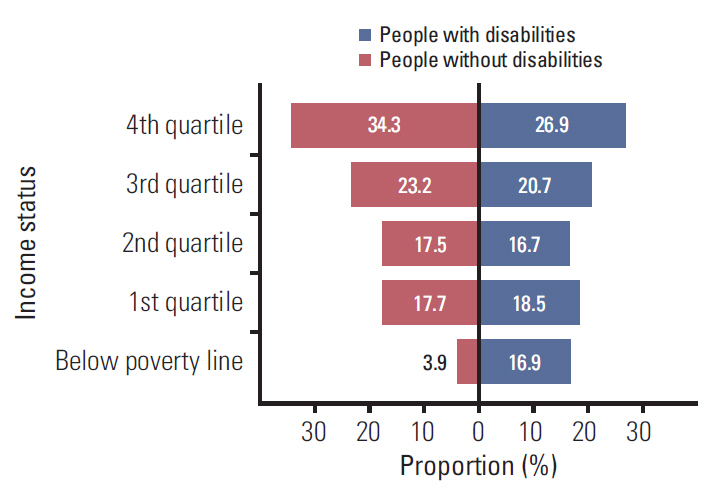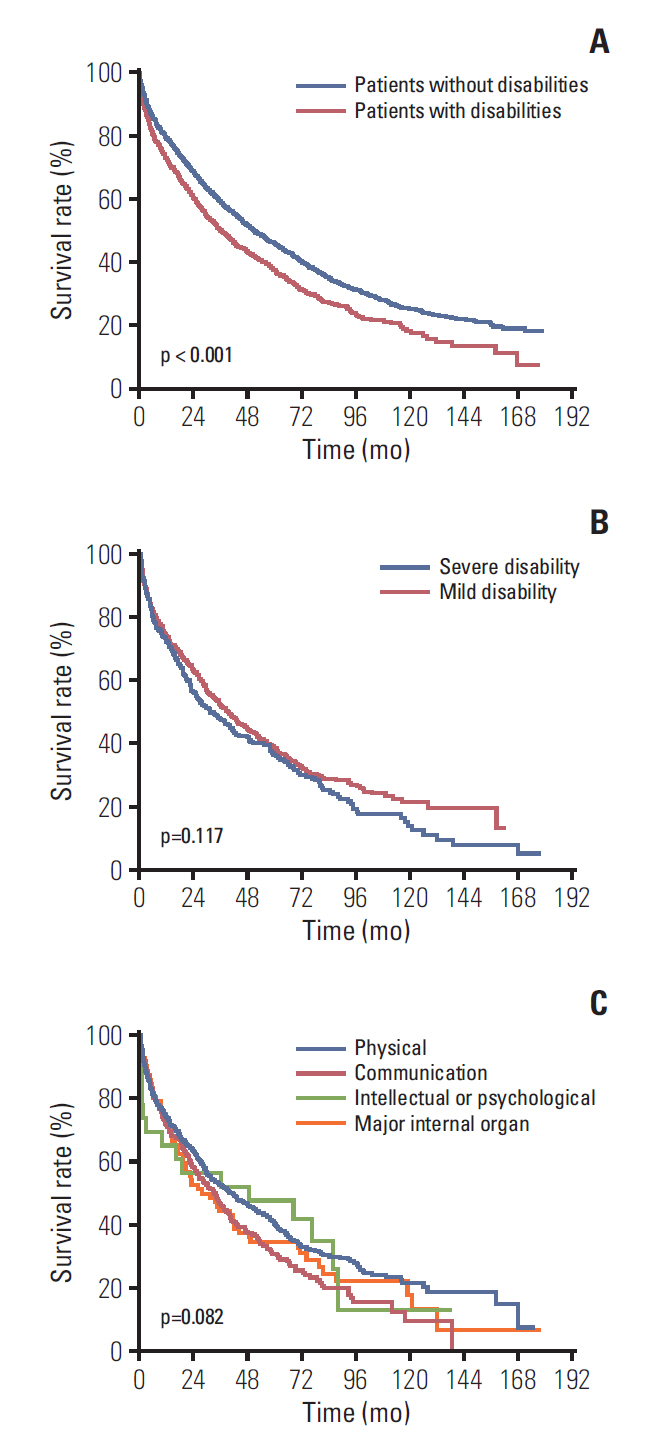Cancer Res Treat.
2020 Jan;52(1):1-9. 10.4143/crt.2018.702.
The Effect of Disability on the Diagnosis and Treatment of Multiple Myeloma in Korea: A National Cohort Study
- Affiliations
-
- 1Division of Hematology-Oncology, Department of Internal Medicine, Chungbuk National University Hospital, Chungbuk National University College of Medicine, Cheongju, Korea
- 2Department of Public Health and Preventive Medicine, Chungbuk National University Hospital, Cheongju, Korea
- 3College of Medicine/Graduate School of Health Science Business Convergence, Chungbuk National University, Cheongju, Korea
- 4T. H. Chan School of Public Health, Harvard University, Boston, MA, USA
- 5Supportive Care Center/Department of Family Medicine, Samsung Medical Center, Seoul, Korea
- 6Department of Digital Health, SAIHST, Sungkyunkwan University, Seoul, Korea
- 7Big Data Steering Department, National Health Insurance Service, Wonju, Korea
- KMID: 2501196
- DOI: http://doi.org/10.4143/crt.2018.702
Abstract
- Purpose
This study aimed to determine whether the diagnosis, treatment approach, and prognosis of multiple myeloma (MM) vary according to the presence and type of disability.
Materials and Methods
Demographic, socioeconomic, and medical data were obtained from the National Disability Database, the Korean Central Cancer Registry, and the Korean National Health Insurance claims database. An age- and sex-matched cohort was established using a 1:3 ratio constituted with 2,776,450 people with disabilities and 8,329,350 people without disabilities. Adult patients diagnosed with MM were subsequently selected from this cohort. Disabilities were categorized as physical, communication, intellectual or psychological, and affecting the major internal organs.
Results
The cohort included 4,090 patients with MM, with a significantly lower rate per 100,000 persons among people with disabilities than among people without disabilities (29.1 vs. 39.4, p < 0.001). People with disabilities were more likely to undergo dialysis treatment at the time of diagnosis (16.3% vs. 10.0%, p < 0.001), but were less likely to undergo autologous stem cell transplantation (37.5% vs. 43.7%, p=0.072). This trend was more evident among patients with intellectual or psychological disabilities. The median overall survival among patients with disabilities was significantly shorter than that among patients without disabilities (36.8 months vs. 51.2 months, p < 0.001).
Conclusion
In Korea, people with disabilities generally have a lower rate of MM diagnosis, receive less intensive treatment, and have a lower survival rate than people without disabilities.
Keyword
Figure
Reference
-
References
1. Jung KW, Won YJ, Kong HJ, Lee ES; Community of Population-Based Regional Cancer Registries. Cancer statistics in Korea: incidence, mortality, survival, and prevalence in 2015. Cancer Res Treat. 2018; 50:303–16.
Article2. Park HJ, Park EH, Jung KW, Kong HJ, Won YJ, Lee JY, et al. Statistics of hematologic malignancies in Korea: incidence, prevalence and survival rates from 1999 to 2008. Korean J Hematol. 2012; 47:28–38.
Article3. Auner HW, Szydlo R, Hoek J, Goldschmidt H, Stoppa AM, Morgan GJ, et al. Trends in autologous hematopoietic cell transplantation for multiple myeloma in Europe: increased use and improved outcomes in elderly patients in recent years. Bone Marrow Transplant. 2015; 50:209–15.
Article4. Brenner H, Gondos A, Pulte D. Recent major improvement in long-term survival of younger patients with multiple myeloma. Blood. 2008; 111:2521–6.
Article5. Kumar SK, Dispenzieri A, Lacy MQ, Gertz MA, Buadi FK, Pandey S, et al. Continued improvement in survival in multiple myeloma: changes in early mortality and outcomes in older patients. Leukemia. 2014; 28:1122–8.
Article6. Korean Statistical Information Service; Korea Statistical Information Services. National survey on persons with disabilities. Seoul: Korea Institute for Health and Social Affairs;2011.7. Jung KW, Park S, Kong HJ, Won YJ, Lee JY, Seo HG, et al. Cancer statistics in Korea: incidence, mortality, survival, and prevalence in 2009. Cancer Res Treat. 2012; 44:11–24.
Article8. Jee SH, Sull JW, Park J, Lee SY, Ohrr H, Guallar E, et al. Bodymass index and mortality in Korean men and women. N Engl J Med. 2006; 355:779–87.
Article9. Kim YI, Kim SY, Cho SJ, Park JH, Choi IJ, Lee YJ, et al. Long-term metformin use reduces gastric cancer risk in type 2 diabetics without insulin treatment: a nationwide cohort study. Aliment Pharmacol Ther. 2014; 39:854–63.
Article10. Seong SC, Kim YY, Khang YH, Park JH, Kang HJ, Lee H, et al. Data resource profile: The National Health Information Database of the National Health Insurance Service in South Korea. Int J Epidemiol. 2017; 46:799–800.11. Korean Statistical Information Service. Number of registered disabled people [Internet]. Daejeon: Statistics Korea;[cited 2018 Apr 26]. Available from: http://kosis.kr/index/index.do.12. Yoon TH, Lee SY, Kim CW, Kim SY, Jeong BG, Park HK. Inequalities in medical care utilization by South Korean cancer patients according to income: a retrospective cohort study. Int J Health Serv. 2011; 41:51–66.
Article13. Fonseca R, Abouzaid S, Bonafede M, Cai Q, Parikh K, Cosler L, et al. Trends in overall survival and costs of multiple myeloma, 2000-2014. Leukemia. 2017; 31:1915–21.
Article14. Cowan AJ, Allen C, Barac A, Basaleem H, Bensenor I, Curado MP, et al. Global burden of multiple myeloma: a systematic analysis for the Global Burden of Disease Study 2016. JAMA Oncol. 2018; 4:1221–7.
Article15. Fujiura GT, Yamaki K. Analysis of ethnic variations in developmental disability prevalence and household economic status. Ment Retard. 1997; 35:286–94.
Article16. Smith JP. Healthy bodies and thick wallets: the dual relation between health and economic status. J Econ Perspect. 1999; 13:144–66.
Article17. Emerson E. Mothers of children and adolescents with intellectual disability: social and economic situation, mental health status, and the self-assessed social and psychological impact of the child's difficulties. J Intellect Disabil Res. 2003; 47(Pt 4-5):385–99.
Article18. Stabile M, Allin S. The economic costs of childhood disability. Future Child. 2012; 22:65–96.
Article19. Kavanagh AM, Krnjacki L, Aitken Z, LaMontagne AD, Beer A, Baker E, et al. Intersections between disability, type of impairment, gender and socio-economic disadvantage in a nationally representative sample of 33,101 working-aged Australians. Disabil Health J. 2015; 8:191–9.
Article20. Halpern MT, Ward EM, Pavluck AL, Schrag NM, Bian J, Chen AY. Association of insurance status and ethnicity with cancer stage at diagnosis for 12 cancer sites: a retrospective analysis. Lancet Oncol. 2008; 9:222–31.
Article21. Byers TE, Wolf HJ, Bauer KR, Bolick-Aldrich S, Chen VW, Finch JL, et al. The impact of socioeconomic status on survival after cancer in the United States: findings from the National Program of Cancer Registries Patterns of Care Study. Cancer. 2008; 113:582–91.22. Frederiksen BL, Dalton SO, Osler M, Steding-Jessen M, de Nully Brown P. Socioeconomic position, treatment, and survival of non-Hodgkin lymphoma in Denmark: a nationwide study. Br J Cancer. 2012; 106:988–95.23. Coppus AM. People with intellectual disability: what do we know about adulthood and life expectancy? Dev Disabil Res Rev. 2013; 18:6–16.
Article24. Patja K, Iivanainen M, Vesala H, Oksanen H, Ruoppila I. Life expectancy of people with intellectual disability: a 35-year follow-up study. J Intellect Disabil Res. 2000; 44(Pt 5):591–9.
Article25. Haveman M, Perry J, Salvador-Carulla L, Walsh PN, Kerr M, Van Schrojenstein Lantman-de Valk H, et al. Ageing and health status in adults with intellectual disabilities: results of the European POMONA II study. J Intellect Dev Disabil. 2011; 36:49–60.
Article26. Riddle I, Romelczyk S, Sparling E. Effective communication for health care providers: a guide to caring for people with disabilities. Newark, DE: Center for Disabilities Studies, University of Delaware;2011.27. Rajkumar SV. Multiple myeloma: 2016 update on diagnosis, risk-stratification, and management. Am J Hematol. 2016; 91:719–34.
Article28. Kumar SK, Callander NS, Alsina M, Atanackovic D, Biermann JS, Castillo J, et al. NCCN guidelines insights: multiple myeloma, version 3.2018. J Natl Compr Canc Netw. 2018; 16:11–20.
Article29. Cavo M, Terpos E, Bargay J, Einsele H, Cavet J, Greil R, et al. The multiple myeloma treatment landscape: international guideline recommendations and clinical practice in Europe. Expert Rev Hematol. 2018; 11:219–37.
Article30. Kristinsson SY, Derolf AR, Edgren G, Dickman PW, Bjorkholm M. Socioeconomic differences in patient survival are increasing for acute myeloid leukemia and multiple myeloma in sweden. J Clin Oncol. 2009; 27:2073–80.
Article




